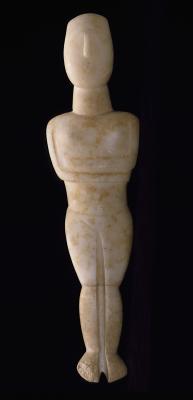
The Cyclades, small islands in the Aegean Sea between Greece and Turkey, had a flourishing Early Bronze Age culture, dating from about 3200 to 2000 B.C. Among the most memorable artifacts of that culture are the marble figurines that were placed in many graves. Most are female, like this one, holding her arms folded beneath the breasts, and reclining rather than standing, indicated by the extended position of the feet. The addition of painted details, such as the eyes, is attested in the ghost of an outline visible in certain light.
The simple geometry of the forms struck a responsive chord in modern artists and accounts for the great appeal of the figurines in the twentieth century. Unfortunately, this popularity led to the plundering of many Clycladic cemeteries in search of the figurines. With the resulting destruction of information on their contexts and the lack of any written documentation from this prehistoric period, interpretation of the meaning and function of the figurines is uncertain.
Scholars now group figurines according to elements of their style. Thus, the broad U-shaped head with its small, high-placed nose, and the distinctive profile with a thick torso and slender legs link our figure to an artist known as the Steiner Master, after the owners of the first figurine to be identified with this style.

